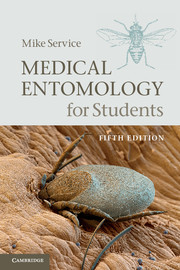Book contents
- Frontmatter
- Contents
- Preface to the first edition
- Preface to the second edition
- Preface to the third edition
- Preface to the fourth edition
- Preface to the fifth edition
- Acknowledgements
- 1 Introduction to mosquitoes (Culicidae)
- 2 Anopheline mosquitoes (Anophelinae)
- 3 Culicine mosquitoes (Culicinae)
- 4 Black flies (Simuliidae)
- 5 Phlebotomine sand flies (Phlebotominae)
- 6 Biting midges (Ceratopogonidae)
- 7 Horse flies (Tabanidae)
- 8 Tsetse flies (Glossinidae)
- 9 House flies and stable flies (Muscidae) and latrine flies (Fanniidae)
- 10 Flies and myiasis
- 11 Fleas (Siphonaptera)
- 12 Sucking lice (Anoplura)
- 13 Bedbugs (Cimicidae)
- 14 Triatomine bugs (Triatominae)
- 15 Cockroaches (Blattaria)
- 16 Soft ticks (Argasidae)
- 17 Hard ticks (Ixodidae)
- 18 Scabies mites (Sarcoptidae)
- 19 Scrub typhus mites (Trombiculidae)
- 20 Miscellaneous mites
- Appendix Names of some chemicals and microbials used in vector control (with common trade names in parentheses)
- Glossary of common terms relevant to medical entomology
- Select bibliography
- Index
- Plate section
- References
11 - Fleas (Siphonaptera)
Published online by Cambridge University Press: 05 June 2012
- Frontmatter
- Contents
- Preface to the first edition
- Preface to the second edition
- Preface to the third edition
- Preface to the fourth edition
- Preface to the fifth edition
- Acknowledgements
- 1 Introduction to mosquitoes (Culicidae)
- 2 Anopheline mosquitoes (Anophelinae)
- 3 Culicine mosquitoes (Culicinae)
- 4 Black flies (Simuliidae)
- 5 Phlebotomine sand flies (Phlebotominae)
- 6 Biting midges (Ceratopogonidae)
- 7 Horse flies (Tabanidae)
- 8 Tsetse flies (Glossinidae)
- 9 House flies and stable flies (Muscidae) and latrine flies (Fanniidae)
- 10 Flies and myiasis
- 11 Fleas (Siphonaptera)
- 12 Sucking lice (Anoplura)
- 13 Bedbugs (Cimicidae)
- 14 Triatomine bugs (Triatominae)
- 15 Cockroaches (Blattaria)
- 16 Soft ticks (Argasidae)
- 17 Hard ticks (Ixodidae)
- 18 Scabies mites (Sarcoptidae)
- 19 Scrub typhus mites (Trombiculidae)
- 20 Miscellaneous mites
- Appendix Names of some chemicals and microbials used in vector control (with common trade names in parentheses)
- Glossary of common terms relevant to medical entomology
- Select bibliography
- Index
- Plate section
- References
Summary
There are about 2500 species and subspecies of fleas in about 220 genera, but only relatively few are important pests of humans. About 94% of species bite mammals, while the remainder are parasitic on birds. Fleas occur almost worldwide, but many have a more restricted distribution; for example the genus Xenopsylla, which contains important plague vectors, is confined to the tropics and warmer parts of some temperate countries.
Medically the most important fleas are Xenopsylla species, such as X. cheopis, which is a vector of plague (Yersinia pestis) and flea-borne murine typhus (Rickettsia typhi). Fleas in the genus Ctenocephalides may be intermediate hosts of cestodes (Dipylidium caninum, Hymenolepis diminuta). Fleas may also be vectors of tularaemia (Francisella tularensis), and the chigoe or jigger flea (Tunga penetrans) ‘burrows’ into people’s feet.
External morphology
Adult fleas are more or less oval in shape and relatively small (1–6 mm); they are compressed laterally and vary from light to dark brown (Plate 19). Wings are absent, but there are three pairs of powerful legs, with the hind legs specialized for jumping. The legs, and much of the body, are covered with bristles and small spines.
The head is approximately triangular, bears a pair of conspicuous eyes (a few species are eyeless), and short three-segmented more or less clubshaped antennae which lie in depressions behind the eyes. The mouthparts point downwards. In some species a row of coarse, well-developed toothlike spines, collectively known as the genal comb or genal ctenidium, is present along the bottom margin of the head (Figs. 11.1, 11.2).
- Type
- Chapter
- Information
- Medical Entomology for Students , pp. 176 - 190Publisher: Cambridge University PressPrint publication year: 2012
References
- 1
- Cited by



